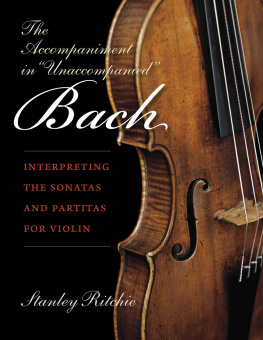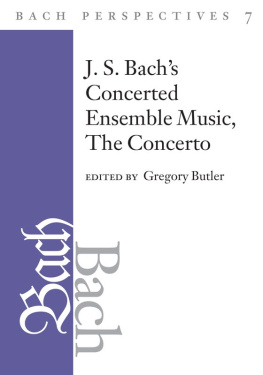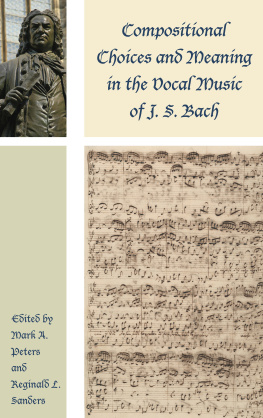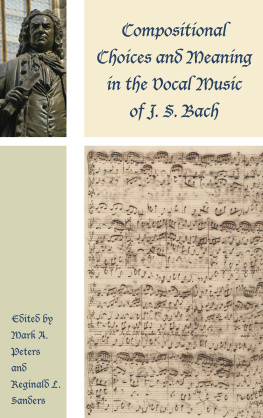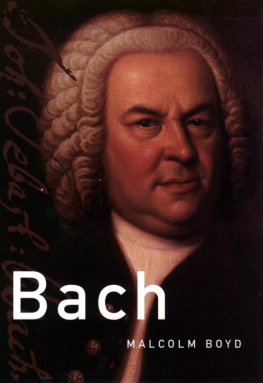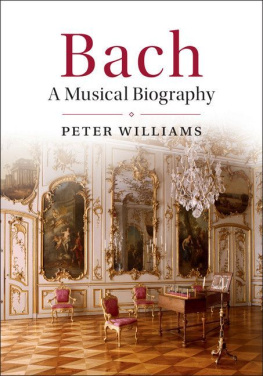
The Accompaniment in Unaccompanied
Bach
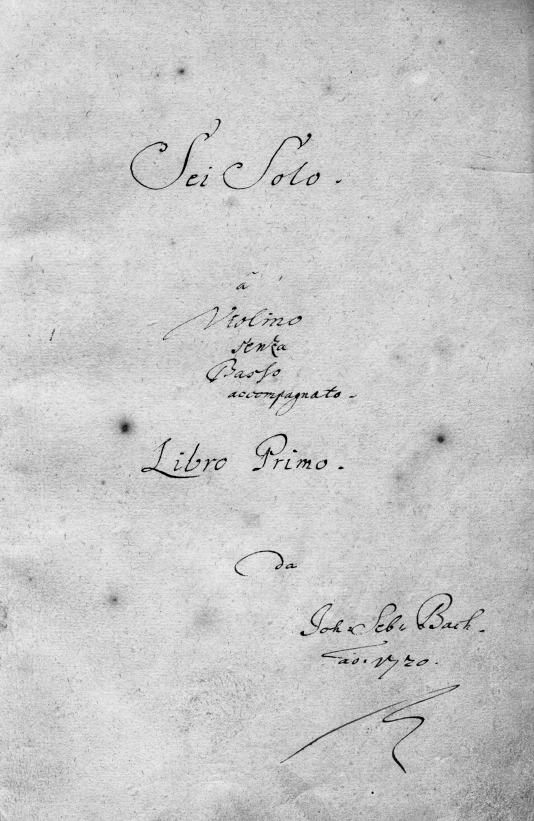
Autograph page of Bachs Sei Solo a Violino senza Basso, Mus. ms. Bach P 967, fol. 1r. Courtesy of Staatsbibliothek zu BerlinPreuischer Kulturbesitz, Musikabteilung mit Mendelssohn-Archiv.
PUBLICATIONS OF THE EARLY MUSIC INSTITUTE
The Accompaniment in Unaccompanied
Bach

INTERPRETING THE SONATAS AND PARTITAS FOR VIOLIN

Stanley Ritchie
INDIANA UNIVERSITY PRESS
Bloomington & Indianapolis
This book is a publication of
INDIANA UNIVERSITY PRESS
Office of Scholarly Publishing
Herman B Wells Library 350
1320 East 10th Street
Bloomington, Indiana 47405 USA
iupress.indiana.edu
2016 by Stanley Ritchie
All rights reserved
No part of this book may be reproduced or utilized in any form or by any means, electronic or mechanical, including photocopying and recording, or by any information storage and retrieval system, without permission in writing from the publisher. The Association of American University Presses Resolution on Permissions constitutes the only exception to this prohibition.
The paper used in this publication meets the minimum requirements of the American National Standard for Information SciencesPermanence of Paper for Printed Library Materials, ANSI Z39.481992.
Manufactured in the United States of America
Library of Congress Cataloging-in-Publication Data
Names: Ritchie, Stanley, author.
Title: The accompaniment in unaccompanied Bach : interpreting the Sonatas and Partitas for violin / Stanley Ritchie.
Other titles: Publications of the Early Music Institute.
Description: Bloomington ; Indianapolis : Indiana University Press, 2016. | ?2016 |
Series: Publications of the Early Music Institute | Includes bibliographical references.
Identifiers: LCCN 2016010954 (print) | LCCN 2016013161 (ebook) | ISBN 9780253021984 (print : alkaline paper) | ISBN 9780253022080 (ebook)
Subjects: LCSH: Bach, Johann Sebastian, 16851750. Sonaten und Partiten, BWV 10011006. violin, | Violin musicInterpretation (Phrasing, dynamics, etc.)
Classification: LCC MT145.B11 R58 2016 (print) | LCC MT145.B11 (ebook) | DDC 787.2/183092dc23
LC record available at http://lccn.loc.gov/2016010954
1 2 3 4 5 22 21 20 19 18 17
He played the violin cleanly and penetratingly and understood to perfection the possibilities of all string instruments. This is evidenced by his solos for the violin and for the violoncello without bass. One of the greatest violinists told me once that he had seen nothing more perfect for learning to be a good violinist, and could suggest nothing better to anyone eager to learn, than the said violin solos without bass.
Carl Philipp Emanuel Bach in a letter to Nicolaus Forkel in December 1774, trans. Hans T. David and Arthur Mendel.
The New Bach Reader, rev. Christoph Wolff.
New York: Norton, 1998.
Contents
Foreword
Stanley Ritchies Interpreting Unaccompanied Bach is a masterful and comprehensive study of Bachs three Sonatas and three Partitas for solo violin. Professor Ritchies cultivated and deeply incisive analysis covers all the technical elements and stylistic considerations involved in arriving at a convincing period-style interpretation of these masterpiecesyet, one never feels that his brilliant dissective ability is, as it often can be, a merely challenging intellectual exercise. The ever-present undercurrent of the passion and love Ritchie feels for these works is indeed the dominating and motivating force for this book. I am not a Baroque violinist. Nevertheless, I highly recommend this book to all violinistsI have no doubt that they will find it, as I have, a source of invaluable information and inspiration.
Mauricio Fuks
Acknowledgments
Writing this book has been a labor of love: studying, performing, and teaching this music have all contributed significantly to my growth as a musician. The decision to write the book was the result, the natural outcome, of my having taught for many years a course in this subject at the Indiana University Jacobs School of Musicthe book is a kind of legacy born of a desire to share my conception with a wider audience. It is only fitting, then, that I acknowledge first the help over the years of my students in the course, who have served as guinea pigsand still doand provided me with frequent insights and the platform from which to share and test my ideas.
I am most grateful to my editors at Indiana University Press, Raina Polivka and Janice Frisch, who have been so generous with their oversight and their guidance through the postcreative obstacle course. The prompt and courteous assistance of Drs. Martina Rebmann and Roland Schmidt-Hensel of the Berlin Staatsbibliothek, who responded immediately to my request for scanned pages of Bachs autograph, certainly helped to expedite the editing process.
I am indebted to my friends and colleagues, Mauricio Fuks and Joseph Silverstein, who have always been supportive of my work, and to Reinhard Goebel for his perceptive criticism.
Perhaps, though, an expression of posthumous gratitude to Bach himself, the consummate master, is in order: he provided us with an incomparable work of art whose careful study has enriched so many generations of musicians. I do hope he approves of my work.
Introduction
Johann Sebastian Bachs Sei Solo Violino senza Basso accompagnato bears the date 1720. Its uniqueness as an extended example of unaccompanied composition is striking, because there are so few compositions of that genre that have come down to us from that period and none of such scope. Heinrich von Bibers Passacaglia from the Rosenkrantz Sonaten of 1675, which bears great similarity to Bachs Ciaccona, and Johann Paul von Westhoffs unaccompanied Suite (1683) and Partitas (1696) each predate Bachs pieces by decades. Johann Georg Pisendels Sonata Violino Solo senza Basso, itself a substantial example of early eighteenth-century virtuosity, is thought to have been composed a few years earlier. Each of these demonstrates the advanced state of polyphonic composition in the German school of violin playing in the time of Bach. Whereas the Italians had previously shown the way, even with the introduction of polyphony by composers such as Biagio Marini in his Sonate, Symphoniae Op. 8 (1626), and Carlo FarinaIl quarto Libro delle Pavane, Gagliarde Sonate, Canzon 2, 4 (1628)it was the Germans who explored and exploited the polyphonic possibilities of the instrument. The final, ingenious work in Bibers 1681 set at first glance appears to be a trio sonata with two individual parts on separate staffs: these are, however, to be played by one violinist. There is ongoing speculation as to the influence the music of all these composers may have had on Bach, even as to the possibility that he was familiar with Pisendels sonata, which certainly cannot be ruled out, but if one examines Johann Jakob Walthers monumental Hortulus Chelicus (1688/1694), even though the pieces in this particular collection have figured bass accompaniment, one cannot help but be struck by the similarity of the chordal writing.
Next page
